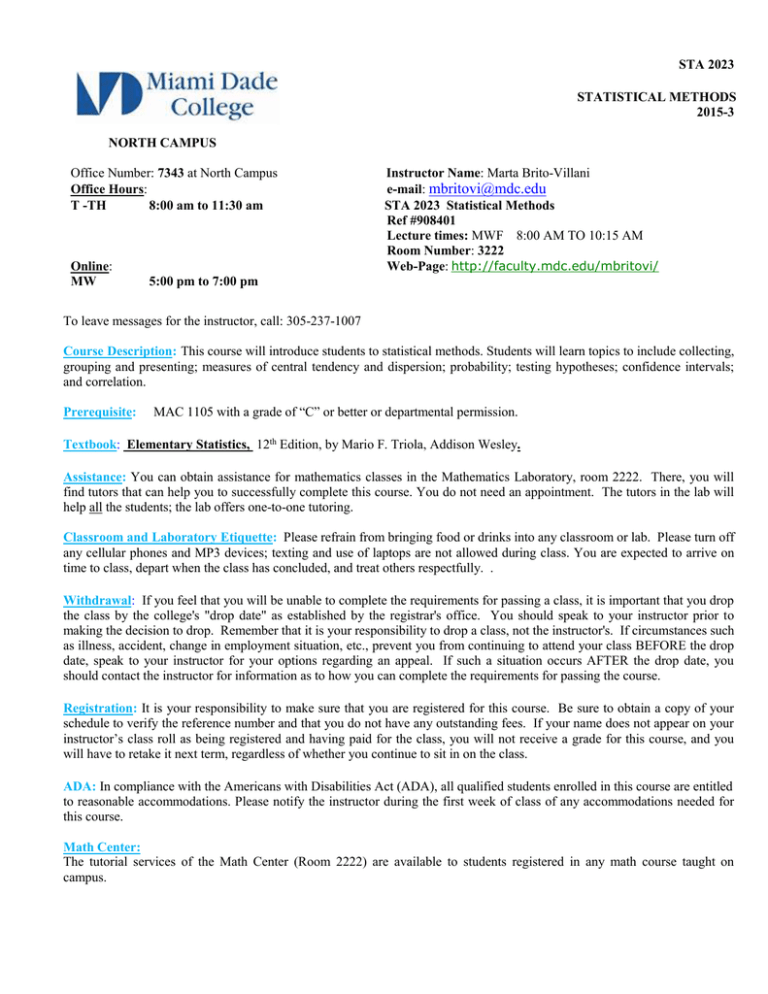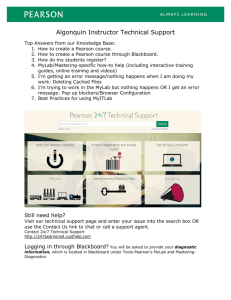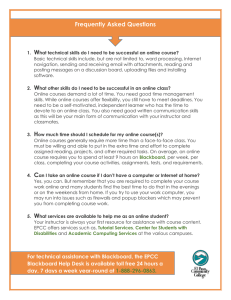Document 17630081
advertisement

STA 2023 STATISTICAL METHODS 2015-3 NORTH CAMPUS Office Number: 7343 at North Campus Office Hours: T -TH 8:00 am to 11:30 am Online: MW Instructor Name: Marta Brito-Villani e-mail: mbritovi@mdc.edu STA 2023 Statistical Methods Ref #908401 Lecture times: MWF 8:00 AM TO 10:15 AM Room Number: 3222 Web-Page: http://faculty.mdc.edu/mbritovi/ 5:00 pm to 7:00 pm To leave messages for the instructor, call: 305-237-1007 Course Description: This course will introduce students to statistical methods. Students will learn topics to include collecting, grouping and presenting; measures of central tendency and dispersion; probability; testing hypotheses; confidence intervals; and correlation. Prerequisite: MAC 1105 with a grade of “C” or better or departmental permission. Textbook: Elementary Statistics, 12th Edition, by Mario F. Triola, Addison Wesley. Assistance: You can obtain assistance for mathematics classes in the Mathematics Laboratory, room 2222. There, you will find tutors that can help you to successfully complete this course. You do not need an appointment. The tutors in the lab will help all the students; the lab offers one-to-one tutoring. Classroom and Laboratory Etiquette: Please refrain from bringing food or drinks into any classroom or lab. Please turn off any cellular phones and MP3 devices; texting and use of laptops are not allowed during class. You are expected to arrive on time to class, depart when the class has concluded, and treat others respectfully. . Withdrawal: If you feel that you will be unable to complete the requirements for passing a class, it is important that you drop the class by the college's "drop date" as established by the registrar's office. You should speak to your instructor prior to making the decision to drop. Remember that it is your responsibility to drop a class, not the instructor's. If circumstances such as illness, accident, change in employment situation, etc., prevent you from continuing to attend your class BEFORE the drop date, speak to your instructor for your options regarding an appeal. If such a situation occurs AFTER the drop date, you should contact the instructor for information as to how you can complete the requirements for passing the course. Registration: It is your responsibility to make sure that you are registered for this course. Be sure to obtain a copy of your schedule to verify the reference number and that you do not have any outstanding fees. If your name does not appear on your instructor’s class roll as being registered and having paid for the class, you will not receive a grade for this course, and you will have to retake it next term, regardless of whether you continue to sit in on the class. ADA: In compliance with the Americans with Disabilities Act (ADA), all qualified students enrolled in this course are entitled to reasonable accommodations. Please notify the instructor during the first week of class of any accommodations needed for this course. Math Center: The tutorial services of the Math Center (Room 2222) are available to students registered in any math course taught on campus. Homework: Homework is mandatory and is assigned each day in Blackboard. For assignments in Blackboard, you need to sign in Blackboard (https://mdc.blackboard.com) using your ID and PW (same that you use for registration). The online Homework is worth 15% of the total grade for the course. To register at course compass check instructions at the end of this syllabus. Extra Credit: Service Learning: AVAILABLE FOR 5% EXTRA CREDIT. Students can make community service and volunteer work an integral component of their academic achievement and be committed to help those in need such as struggling students with humility and sincerity. Students will tutor MAT 0028 students assigned for the instructor for 20 documented hours to earn service learning points which will be considered extra credit. Grading Scale: A B C D F Average of 90-100% Average of 80-89% Average of 70-79% Average of 60-69% Average under 59% Evaluation Policy: Eight on line quizzes, 4 Tests and a Cumulative Final will be administered during the term. The final grade will be: 5% Participation in Class/ Class work 15% Homework (5 lowest will be dropped) 20% Quizzes (lowest will be dropped) 30% 4 Tests 30% Final Test The final grade will not exceed more than one letter grade of the grade of the final. The student can use the final exam grade to replace a missing test .No make-up examinations will be given. Cheating will not be tolerated in this course. Any student caught cheating will receive an automatic "F" in the course. Attendance: Roll will be taken every class. For every three absences, a 2% will be lowered from the final grade, also three tardiness counts for one absence. Students with two or more absences will be withdrawn from the class. Please be prompt, late arrivals are disturbing for the instructor and fellow students, you should plan to be on time independently of traffic, weather, parking. Students are expected to attend and participate in class. Students are responsible for all material covered in class and to save this syllabus for reference throughout the semester. Incomplete: The grade of I (Incomplete) is given in the rare case that a student is PASSING a class but for some extenuating circumstance is unable to complete the last part (usually the final exam) of the class. If you are not passing your class, it is not possible for your instructor to give you an I. Note that you will have one full term (fall or winter) to complete the requirements of your incomplete contract. If you do not complete your requirements in that time, the ‘I’ generally will automatically change to an F on your records. The instructor makes the determination as to whether you are eligible for an Incomplete. IMPORTANT DATES: Classes begin Last day for drop with W (16 week classes only) Classes end Final Exam Holidays: Memorial Day M May 9th R Jun 2nd F Jun 17th Jun 15th M May 30th Tentative schedule: Class Sections 1 2) 3) 4) 5) 6) 7) 8) 9) 2 3 10) 11) 12) 4 5 13) Introduction to course and discuss syllabus 1.2 Statistical Critical Thinking 1.3 Types of Data 1.4 Collecting Sample Data 2.2 Frequency Distributions 2.3 Histograms; Statistical Graphics QUIZ # 1 (Blackboard) Online 3.2: Measures of Center 3.3 Measures of Variation 3.4 Measures of Relative Standing and Boxplots QUIZ #2 (Blackboard) Online Review for Test #1 TEST #1 4.2 Basic Concepts of Probability 4.3 The Addition Rule 4.4 The Multiplication Rule Basics 4.5 Complements and Conditional Probability 4.6 Counting Rules QUIZ # 3(Blackboard) Online 5.2 Probability Distributions 5.3 Binomial Probability Distribution 5.4 Parameters: Mean, Variance, and Standard Deviation of Binomial Distribution QUIZ #4(Blackboard) Online Review for Test #2 TEST #2 6.2 The Standard Normal Distribution 6.3 Applications of Normal Distributions 6.4 Sampling Distributions and Estimators 6.5 The Central Limit Theorem 6.7: Normal Approximation to the Binomial QUIZ #5 (Blackboard) Online 7.2 Estimating a Population Proportion 7.3 Estimating a Population Mean: Known and Not Known QUIZ #6 (Blackboard) Online Review for Test 3 TEST #3 8.2 Basics of Hypothesis Testing 8.3 Testing a Claim about a Proportion 8.4 Testing a Claim about a Mean: Known and Not Known QUIZ #7 (Blackboard) Online 9.2 Two Proportions (Optional) 9.3 Two Means: Independent Samples(Optional) 14) 15) 16) 17) 18) 19) 20) 9.4 Two Dependent Samples (Matched Pairs) (Optional) 10.2 Correlation(Optional) 10.3 Regression (Optional) QUIZ #8 (ANGEL) Online(Optional) Review for Test 4 TEST #4 Final Exam Review 6 FINAL EXAM I reserve the right to make changes in the test dates as needed. Any changes will be announced in class as far in advance as possible. The schedule is tentative and it will be adjusted in the case of any unforeseen circumstance. Miami Dade College Learning Outcomes: Through the academic disciplines and co-curricular activities, Miami Dade College provides multiple, varied, and intentional learning experiences to facilitate the acquisition of fundamental knowledge and skills and the development of attitudes that foster effective citizenship and life-long learning. This course will meet the following outcomes: Communicate effectively using listening, speaking, reading and writing skills. In this course, the communication outcome will be reinforced by using mathematical symbols to express mathematical ideas (mathematics as a form of communication) • Use quantitative analytical skills to evaluate and process numerical data. Numbers are the language in math. In this class, you will have to be able to read and identify pertinent numerical data in word problems. You will be required to manipulate the data using analysis of data collected. • Solve problems using critical and creative thinking and scientific reasoning. Solving problems is not enough. You must be able to critically look at a problem and determine whether or not the answer make sense. You must be able to determine a logical sequence of steps to solve problems both qualitative and numerical. Critical thinking is heavily reinforced in this course. • Formulate strategies to locate, evaluate, and apply information. This outcome is not reinforced in this course. • Demonstrate knowledge of diverse cultures, including global and historical perspectives. This outcome is not reinforced in this course. • Create strategies that can be used to fulfill personal, civic, and social responsibilities. This outcome is not reinforced in this course. • Demonstrate knowledge of ethical thinking and its application to issues in society. This outcome is not reinforced in this course. • Use computer and emerging technologies effectively. All homework assignments will be completed using Course Compass (my math lab) an on line course tool. In addition important information will be posted in course compass and all progress report will be sent to you via email. Students must therefore be able to use the internet, and retrieve email. Students will be able to use graphing calculators • Demonstrate an appreciation for aesthetics and creative activities. This outcome is not reinforced in this course. • Describe how natural systems function and recognize the impact of humans on the environment. This outcome is not reinforced in this course Course Competencies: 1 2 3 4 5 6 7 8 9 10 11 12 13 14 15 16 17 18 19 20 21 22 23 24 Construct a frequency distribution, which also shows cumulative and relative frequencies Construct a histogram Construct and interpret stem-and-leaf plots Compute measures of central tendency Compute measures of dispersion Find the percentile of a score or find the score corresponding to a percentile Construct a box-and-whisker diagram Use various counting rules, including the Multiplication Rule, Permutations and Combinations Know the meanings of sample space, outcome, event, classical vs. empirical probability Compute probabilities of simple events, complement probabilities, and odds Apply the addition rules of probability Apply the multiplication rules of probability Compute conditional probabilities Understand the meaning of a probability distribution and be able to construct discrete probability distributions Compute the mean & variance of a probability distribution Find the expected value of a discrete probability distribution Compute probabilities using the binomial probability distribution Apply the empirical rule for normally distributed data Calculate z-scores and find probabilities for normally distributed data Compute the mean of the sampling distribution of the means or proportions Apply the Central Limit Theorem Apply the normal approximation to the binomial distribution Construct confidence intervals for proportions Construct confidence intervals for a mean ( Known or Not known) 25 26 Perform hypothesis tests for proportions Perform hypothesis tests for means ( Known or Not known) 27 28 29 30 31 Perform hypothesis tests for variances or standard deviations (OPTIONAL) Compute the p-value associated with a hypothesis test Understand the relationship between a confidence interval and a two-tail hypothesis test. Perform hypothesis tests for the difference between two means (independent samples) Perform hypothesis tests for the difference between two means (small, dependent samples: Matched Pairs.) Perform hypothesis tests for the difference between two proportions Construct a scatter-plot for paired data Compute and understand the meaning of the linear correlation coefficient Determine the linear regression equation for paired data Be able to graph a linear regression equation and use it to make predictions 32 33 34 35 36 Get started with a Pearson MyLab and your Blackboard First, make sure you have these 2 things… Email address: You'll get some important emails from your instructor at this address. Access code or credit card: The required access code comes either with your book or by itself at your bookstore. Alternatively, you can buy instant access with a credit card or PayPal account during registration. Next, register! 1. Log in to your campus’s Blackboard Learn.From here, look for a link to your MyLab to begin the registration process. 2. Sign in with your Pearson account: a. If this is the first time you have taken a Pearson MyLab or Mastering course linked to your learning management system, you will be prompted to login with your Pearson account. If you have a Pearson account, enter the username and password. If you don’t have a Pearson account, select the option to Create a new Pearson account. Once complete, move to step #4. b. If you have previously taken a Pearson MyLab or Mastering course linked to your learning management system you will not be prompted to login and you will be asked to enter your access code (see step #4) 3. When prompted for access, click the Access Code button if you purchased a package with an access code from the bookstore, OR purchase instant access now by clicking on the purchase options under the Use a Credit Card or PayPal section. You may also select Temporary Access without payment for 14 days. 4. You are now registered! Click on the “Go to your course” button to access your MyLab or Modified Mastering product. Need help? Read this helpful article about Learning Management Systems: http://247pearsoned.custhelp.com/app/answers/detail/a_id/11853 Or visit our 24/7 Technical Support site at http://247pearsoned.custhelp.com.

